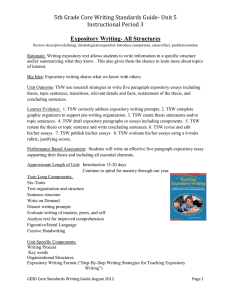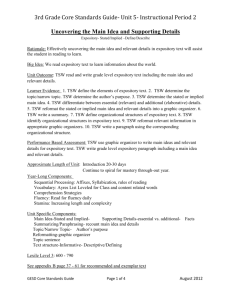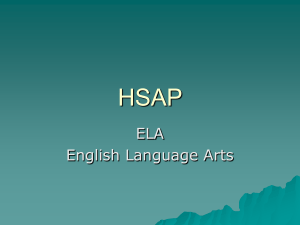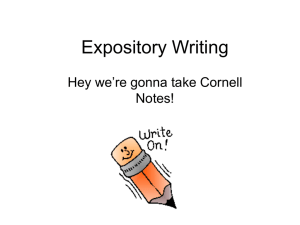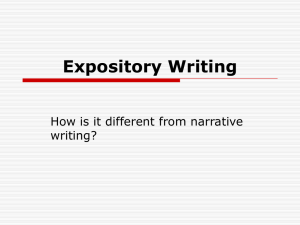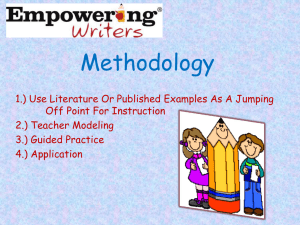4.R.4 Poetry
advertisement
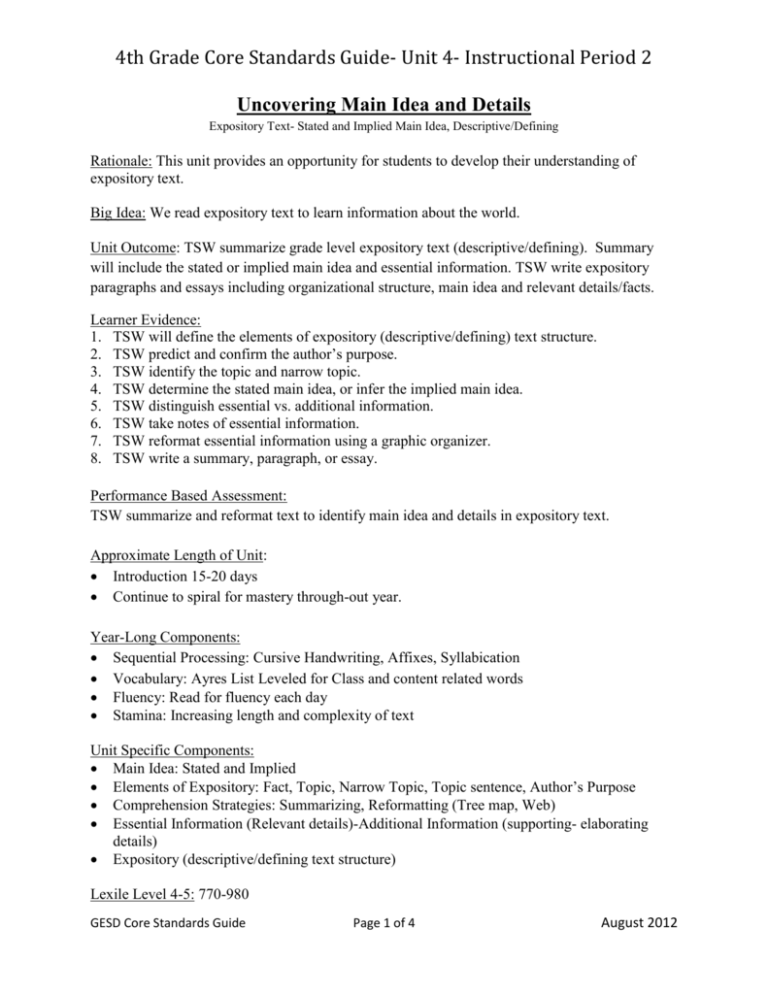
4th Grade Core Standards Guide- Unit 4- Instructional Period 2 Uncovering Main Idea and Details Expository Text- Stated and Implied Main Idea, Descriptive/Defining Rationale: This unit provides an opportunity for students to develop their understanding of expository text. Big Idea: We read expository text to learn information about the world. Unit Outcome: TSW summarize grade level expository text (descriptive/defining). Summary will include the stated or implied main idea and essential information. TSW write expository paragraphs and essays including organizational structure, main idea and relevant details/facts. Learner Evidence: 1. TSW will define the elements of expository (descriptive/defining) text structure. 2. TSW predict and confirm the author’s purpose. 3. TSW identify the topic and narrow topic. 4. TSW determine the stated main idea, or infer the implied main idea. 5. TSW distinguish essential vs. additional information. 6. TSW take notes of essential information. 7. TSW reformat essential information using a graphic organizer. 8. TSW write a summary, paragraph, or essay. Performance Based Assessment: TSW summarize and reformat text to identify main idea and details in expository text. Approximate Length of Unit: Introduction 15-20 days Continue to spiral for mastery through-out year. Year-Long Components: Sequential Processing: Cursive Handwriting, Affixes, Syllabication Vocabulary: Ayres List Leveled for Class and content related words Fluency: Read for fluency each day Stamina: Increasing length and complexity of text Unit Specific Components: Main Idea: Stated and Implied Elements of Expository: Fact, Topic, Narrow Topic, Topic sentence, Author’s Purpose Comprehension Strategies: Summarizing, Reformatting (Tree map, Web) Essential Information (Relevant details)-Additional Information (supporting- elaborating details) Expository (descriptive/defining text structure) Lexile Level 4-5: 770-980 GESD Core Standards Guide Page 1 of 4 August 2012 4th Grade Core Standards Guide- Unit 4- Instructional Period 2 See appendix B pages 63 - 76 for recommended and exemplar text. Fluency Rate: 140-160WPM Academic Vocabulary: Stated main idea, implied main idea, elements of expository, fact, topic, narrow topic, topic sentence, author’s purpose, summarizing, reformatting, tree map, web, essential information, relevant details, additional information, supporting, elaborating details, expository Integrated Text Usage Component: This unit requires students to comprehend a variety of expository text, including but not limited to biographies, diaries, articles, autobiographies, journals, and Internet resources. Assessment Strategy: Read the question before reading the text Code the text Use graphic organizers to organize thoughts Common Core Standards: 4.RI.1. Refer to details and examples in a text when explaining what the text says explicitly and when drawing inferences from the text. 4.RI.2. Determine the main idea of a text and explain how it is supported by key details; summarize the text. 4.RI.5. Describe the overall structure (e.g. chronology, comparison, cause/effect, problem/solution, descriptive/defining) of events, ideas, concepts, or information in a text or part of a text. 4.RI.7. Interpret information presented visually, orally, or quantitatively (e.g., in charts, graphs, diagrams, time lines, animations, or interactive elements on Web pages) and explain how the information contributes to an understanding of the text in which it appears. 4.RI.10. By the end of the year, read and comprehend informational texts including history/social studies, science, and technical texts, in the grades 4-5 text complexity band proficiently, with scaffolding as needed at the high end of the range. 4.L.2. Demonstrate command of the conventions of standard English capitalization, punctuation, and spelling when writing. a. Use correct capitalization. b. Use commas and quotation marks to mark direct speech and quotations from a text. c. Use a comma before a coordinating conjunction in a compound sentence. d. Spell grade-appropriate words correctly, consulting references as needed. GESD Core Standards Guide Page 2 of 4 August 2012 4th Grade Core Standards Guide- Unit 4- Instructional Period 2 4.L.3. Use knowledge of language and its conventions when writing, speaking, reading or listening. a. Choose words and phrases to convey ideas precisely. b. Choose punctuation for effect. c. Differentiate between contexts that call for formal English (e.g., presenting ideas) and situations where informal discourse is appropriate (e.g., small-group discussion). 4.L.6 Acquire and use accurately grade-appropriate general academic and domain-specific words and phrases, including those that signal precise actions, emotions, or states of being and that are basic to a particular topic. 4.SL.2. Paraphrase portions of a text read aloud or information presented in diverse media and formats, including visually, quantitatively, and orally. 4.SL.4. Report on a topic or text, tell a story, or recount an experience in an organized manner, using appropriate facts and relevant, descriptive details to support main ideas or themes; speak clearly at an understandable pace. 4.SL.5. Add audio recordings and visual displays to presentations when appropriate to enhance the development of main ideas or themes. 4.SL.6. Differentiate between contexts that call for formal English (e.g., presenting ideas) and situations where informal discourse is appropriate (e.g., small group discussion); use formal English when appropriate to task and situation. 4.W.2. Write informative/explanatory text to examine a topic and convey ideas and information clearly. a. Introduce a topic clearly and group related information in paragraphs and sections; include formatting (e.g., headings), illustrations, and multimedia when useful to aiding comprehension. b. Develop the topic with facts, definitions, concrete details, quotations, or other information and examples related to the topic. c. Link ideas within categories of information using words and phrases (e.g., another, for example, also, because). d. Use precise language and domain-specific vocabulary to inform about or explain the topic. e. Provide a concluding statement or section related to the information or explanation presented. 4.W.4. Produce clear and coherent writing in which the development and organization are appropriate to task, purpose, and audience. 4.W.6. With some guidance and support from adults, use technology, including the Internet, to produce and publish writing as well as to interact and collaborate with others; demonstrate sufficient command of keyboarding skills to type a minimum of one page in a single-sitting. GESD Core Standards Guide Page 3 of 4 August 2012 4th Grade Core Standards Guide- Unit 4- Instructional Period 2 4.W.8. Recall relevant information from experiences or gather relevant information from print and digital sources; take notes and categorize information, and provide a list of sources. 4.W.9. Draw evidence from informational texts to support analysis, reflection, and research. b. Apply grade 4 Reading standards to informational texts (e.g., “Explain how an author uses reasons and evidence to support particular points in a text”). Arizona State Standards: S3C1PO1 Identify main idea and supporting details in expository text S3C1PO2 Distinguish fact from opinion in expository text S3C1PO3 Determine author’s purpose for writing expository text S3C1PO4 Locate specific information by using organizational features of expository text. S3C1PO5 Identify appropriate print and electronic reference sources needed for a purpose. S3C1PO6 Interpret information from graphic features S3C1 PO8 Draw valid conclusions based on information gathered from expository text. GESD Core Standards Guide Page 4 of 4 August 2012
